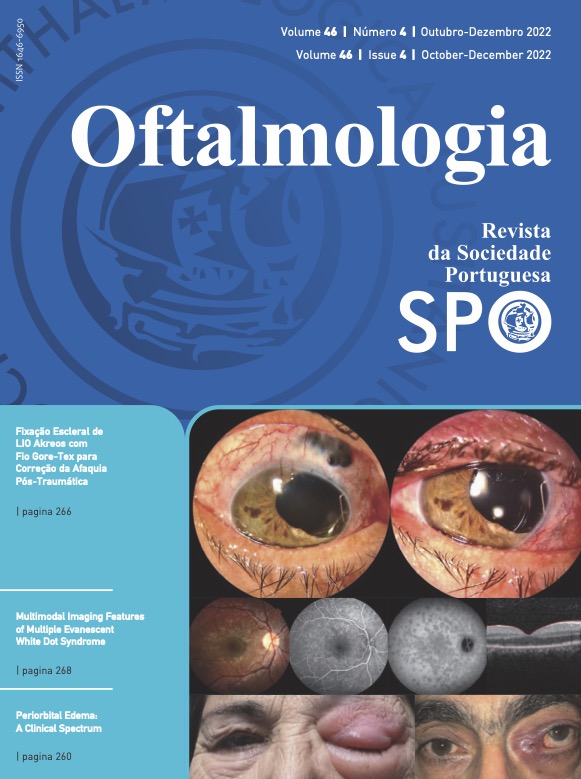Outcomes of Planed Intravitreal Therapy Interruption due to COVID-19 in Patients with Diabetic Macular Edema
DOI:
https://doi.org/10.48560/rspo.25934Keywords:
COVID-19, Diabetes Mellitus, Intravitreal Injections, Macular Edema/drug therapyAbstract
INTRODUCTION: Our aim was to evaluate the outcomes of planed intravitreal injection (IVI) interruption in eyes with diabetic macular edema (DME) and the overall impact of COVID-19 in IVI.
METHODS: Retrospective analysis of clinical data of eyes with DME undergoing treatment with IVI, that missed an IVI by their doctor’s decision (based on an implemented treatment guideline) due to COVID-19 pandemic, between 19 March 2020 and 2 May 2020. Primary outcomes were the best corrected visual acuity (BCVA) and the central foveal thickness (CFT) in the first appointment after the missed IVI and after 6 months. Secondary outcomes were the evolution of BCVA and CFT in eyes that missed IVI by patient’s decision and the comparison of the overall number of IVI performed, missed by doctor’s decision, and missed by patient’s decision during the study period and the same period in 2019.
RESULTS: Between 19 March and 2 May 2020, 132 eyes with DME missed an IVI by doctor’s decision. Before the missed IVI, BCVA was 65 [5-85] ETDRS letters and CFT was 338 [192-1277] μm. In the first appointment after the missed IVI, BCVA and CFT were 65 [5-85] ETDRS letters and 320 [204-1154] μm, respectively. After 6 months of the missed IVI, BCVA was 70 [5-85] ETDRS letters and CFT was 291 [185-868] μm. In the same period, 41 eyes missed IVI by patient’s decision. Before the missed IVI, BCVA was 60 [5-85] ETDRS letters and CFT was 336 [178-622] μm. In the first appointment after the missed IVI, BCVA was 60 [5-80] ETDRS letters and CFT was 333 [202-1041] μm. After 6 months of the missed IVI, BCVA was 60 [5-85] ETDRS letters and CFT was 285 [205-647] μm. Between 19 March and 2 May 2019, a total of 693 IVI were performed in medical retina patients in our center. During the same period in 2020, 272 IVI were administered, 391 were missed by doctor’s decision and 80 IVI were missed by patient’s decision.
CONCLUSION: With the implementation of treatment guidelines, it was possible to keep an overall good control of CFT, without deterioration of BCVA.
Downloads
References
Carrasco J, Pietsch G-A, Nicolas M-P, Koerber C, Bennison C, Yoon J. Real-world effectiveness and real-world cost-effectiveness of intravitreal aflibercept and intravitreal ranibizumab in neovascular age-related macular degeneration: Systematic Review and Meta-Analysis of Real-World Studies. Adv Ther. 2020;37:300-15. doi:10.1007/s12325-019-01147-6
Clark WL, Boyer DS, Heier JS, Brown DM, Haller JA, Vitti R, et al. Intravitreal aflibercept for macular edema following branch retinal vein occlusion. Ophthalmology. 2016;123:330-36. doi:10.1016/j.ophtha.2015.09.035
Nguyen QD, Shah SM, Khwaja AA, Channa R, Hatef H, Do DV, et al. Two-Year Outcomes of the Ranibizumab for Edema of the Macula in Diabetes (READ-2) Study. Ophthalmology. 2010;117:2146-51. doi:10.1016/j.ophtha.2010.08.016
Recommendations For Urgent and Nonurgent Patient Care [Internet]. American Academy of Ophthalmology. March 2020 [cited May 2021]. Available from: https://www.aao.org/headline/new-recommendations-urgent-nonurgent-patient-care.
Ehlken C, Helms M, Böhringer D, Agostini HT, Stahl A. Association of Treatment Adherence With Teal-life VA Outcomes in AMD, DME, and BRVO Patients. Clin Ophthalmol. 2017;2:13-20. doi:10.2147/OPTH.S151611
Weiss M, Sim DA, Herold T, Schumann R, Liegl R, Kern C, et al. Compliance and adherence of patients with diabetic macular edema to intravitreal anti–vascular endothelial growth factor therapy in daily practice. Retina. 2018;38:2293-2300. doi:10.1097/IAE.0000000000001892
Song W, Singh RP, Rachitskaya AV. The effect of delay in care among patients requiring intravitreal injections. Ophthalmol Retina. 2021.S2468-6530:30507-8. doi:10.1016/j.oret.2020.12.020
Carnevali A, Giannaccare G, Gatti V, Scuteri G, Randazzo G, Scorcia V. Intravitreal Injections During COVID-19 Outbreak: Real-world Experience From an Italian Tertiary Referral Center. Eur J Ophthalmol. 2021;31:10-2. doi:10.1177/1120672120962032
Korobelnik J-F, Loewenstein A, Eldem B, Joussen AM, Koh A, Lambrou GN, et al. Guidance for Anti-VEGF Intravitreal Injections During the COVID-19 Pandemic. Graefes Arch Clin Exp Ophthalmol. 2020;258:1149-56. doi:10.1007/s00417-020-04703-x
Moussa M, Elshorbagy MS, Emarah A, Gaber R, Moussa OM, El-Bradey M, et al. Intravitreal Injections of Anti-VEGF Agents During COVID-19 Pandemic: Clinical Audit From Tanta University Hospital. Int Ophthalmol. 2021;41:1437-43. doi:10.1007/s10792-021-01719-y
Yang K-B, Feng H, Zhang H. Effects of the COVID-19 pandemic on anti-vascular endothelial growth factor treatment in China. Front Med. 2020;7:576275. doi:10.3389/fmed.2020.576275
Saleh OA, Jammal H, Alqudah N, Alqudah A, Abu-Yaghi N. Clinical Experience in the administration of intravitreal injection therapy at a tertiary university Hospital in Jordan during the COVID-19 lockdown. Clin Ophthalmol. 2020;14:2473-80. doi:10.2147/OPTH.S269179
Naravane AV, Mundae R, Zhou Y, Santilli C, Kuijk FJ,Nazari H, et al. Short term visual and structural outcomes of anti-vascular endothelial growth factor (anti-VEGF) treatment delay during the first COVID-19 wave: a pilot study. PLoS ONE. 2021;16:e0247161. doi:10.1371/journal.pone.0247161
Yalamanchili SP, Maatouk CM, Enwere DU, Conti TF, Hom GL, Briskin IN, et al. The short-term effect of a single lapse in anti–vascular endothelial growth factor treatment for diabetic macular edema within routine clinical practice. Am J Oph- thalmol. 2020;219:215-21. doi:10.1016/j.ajo.2020.06.040
Elfalah M, AlRyalat SA, Toro MD, Rejdak R, Zweifel S, Nazzal R, et al. Delayed intravitreal Anti-VEGF therapy for patients during the COVID-19 Lockdown: An Ethical Endeavor. Clin Ophthalmol. 2021;15:661-9. doi:10.2147/OPTH.S289068
Wasser LM, Weill Y, Brosh K, Magal I, Potter M, Strassman I, et al. The Impact of COVID-19 on Intravitreal Injection Compliance. SN Compr Clin Med. 2020;1-4. doi:10.1007/s42399-020-00614-4
Borrelli E, Grosso D, Vella G, Sacconi R, Querques L, Zucchi- atti I, et al. Impact of COVID-19 on Outpatient Visits and Intravitreal Treatments in a Referral Retina Unit: Let’s Be Ready For a Plausible “Rebound Effect.” Graefes Arch Clin Exp Ophthalmol. 2020;258):2655-60. doi:10.1007/s00417-020-04858-7
Downloads
Published
How to Cite
Issue
Section
License
Copyright (c) 2022 Revista Sociedade Portuguesa de Oftalmologia

This work is licensed under a Creative Commons Attribution-NonCommercial 4.0 International License.
Do not forget to download the Authorship responsibility statement/Authorization for Publication and Conflict of Interest.
The article can only be submitted with these two documents.
To obtain the Authorship responsibility statement/Authorization for Publication file, click here.
To obtain the Conflict of Interest file (ICMJE template), click here





